Last week, Wahoo and Zwift announced their first-ever trainer collab: the KICKR CORE Zwift One.
It’s the KICKR Core we know and love from Wahoo, with a Zwift Cog installed in place of a cassette, and a Zwift Click included for virtual shifting.
I’ve had the CORE One (yes, I’m shortening the name) in the Zwift Insider Pain Lab for a few weeks, running it through its paces. And today I’ll be sharing my experience, along with key specs and other details. Let’s go!
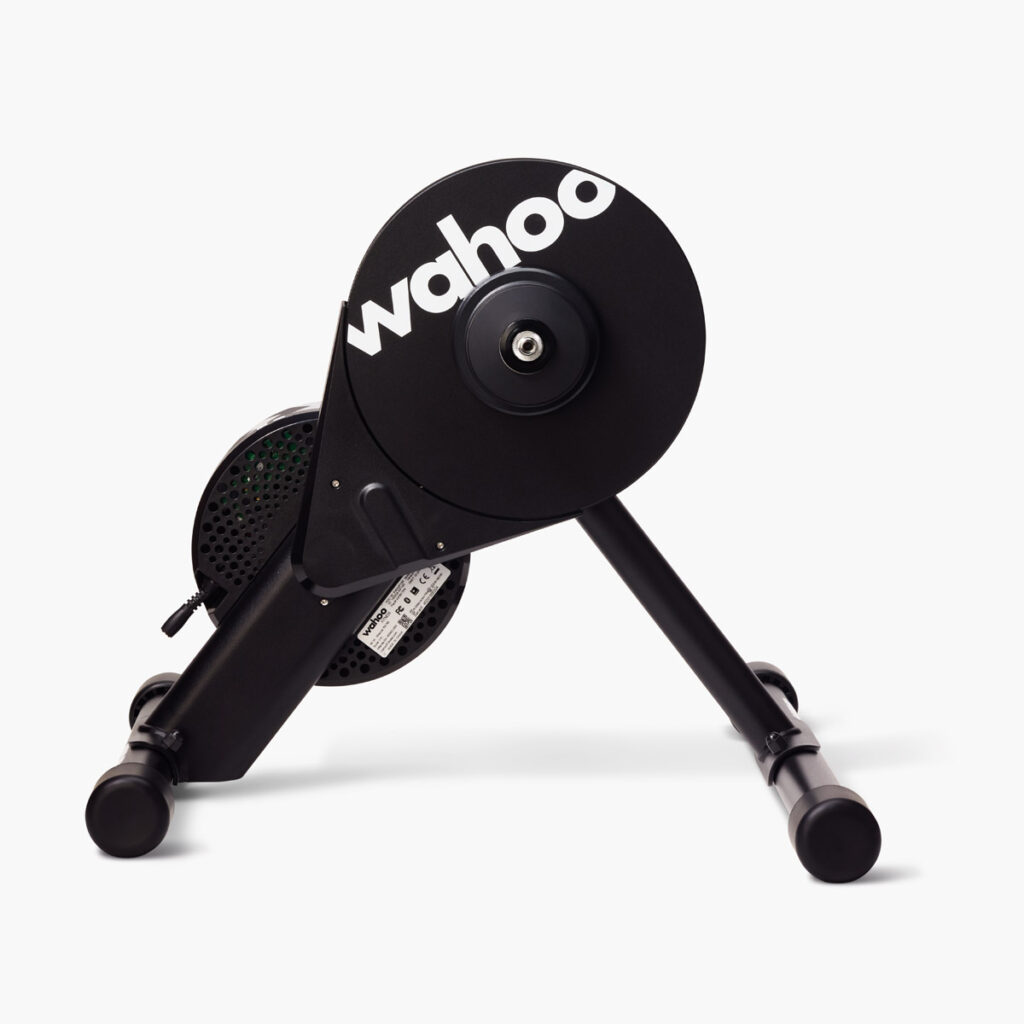
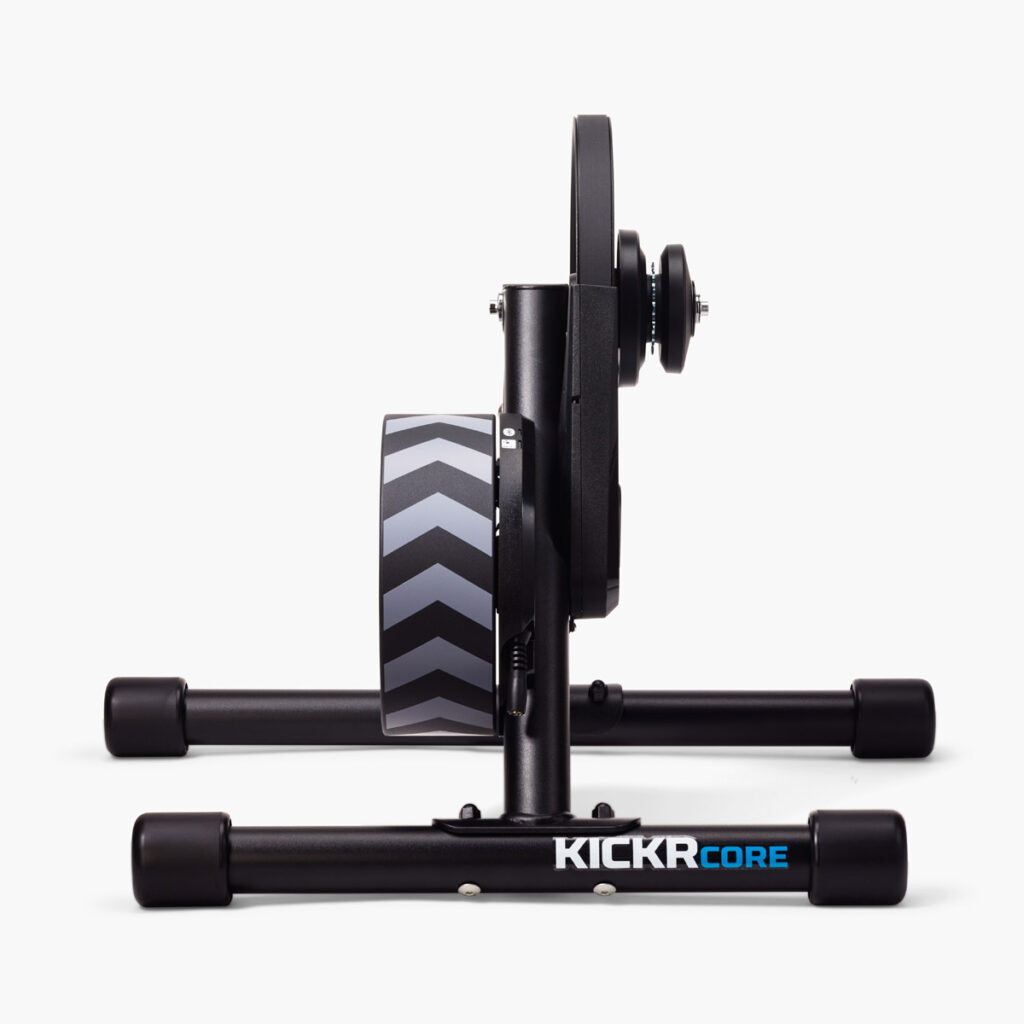
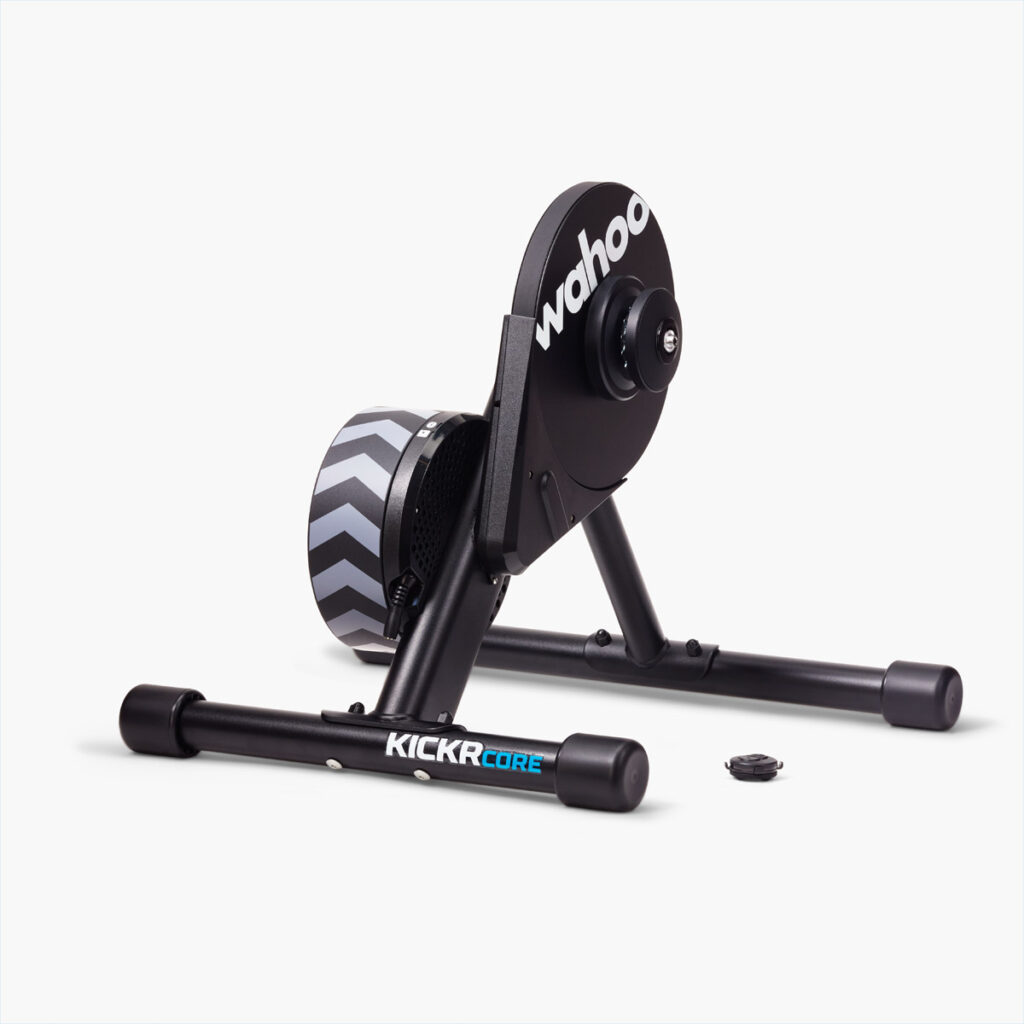
Features and Specs
The CORE One is priced a full $1000 below Wahoo’s newest KICKR, the KICKR MOVE. And the CORE One comes with a full year of Zwift membership, while the KICKR MOVE does not!
So how do the two trainers compare?
| KICKR CORE Zwift One | KICKR MOVE | |
| Price | $599/£549/€599 | $1,599/€1,599/£1399 |
| Max Power | 1800W | 2200W |
| Accuracy | +/-2% | +/-1% |
| Calibration | Automatic | Automatic |
| Cadence | Built In | Built In |
| Brake/Drive Type | Electromagnetic | Electromagnetic |
| Max Gradient | 16% | 20% |
| Weight | 40lb/18kg | 64lb/29kg |
| CLIMB Compatible | Yes | With base adapter |
| ANT+ and Bluetooth Connectivity | ✅ | ✅ |
| Multiperipheral Bluetooth | Up to 3 connections | Up to 3 connections |
| Axle Compatibility | 130/135mm quick release, 12×142/12×148 thru-axle | 130/135mm quick release, 12×142/12×148 thru-axle |
| Pre-Installed Cassette | Zwift Cog | 11-Speed |
| Virtual Shifting | ✅ | Coming soon |
| Direct Connect | ❌ | ✅ |
| WiFi Connectivity | ❌ | ✅ |
| ERG Easy Ramp | ❌ | ✅ |
| Odometer | ❌ | ✅ |
| 10Hz Race Mode | ❌ | ✅ |
| Fore-Aft Motion | ❌ | ✅ |
| Includes 1 Year of Zwift | ✅ | ❌ |
Unboxing/Setup
CORE One setup is very easy. It can be done by just about anyone, even if you’re not an experienced cyclist.
Unboxing and Assembly
My CORE One arrived in the same box as a standard KICKR Core, but Wahoo says this will be changed soon. Assembly was quite easy:
- Open up the collapsable front arm
- Install both legs using the enclosed hex tool
- Install the correct axle adapters for my bike (135mm quick release) – if you aren’t sure which adapters to use, read this post

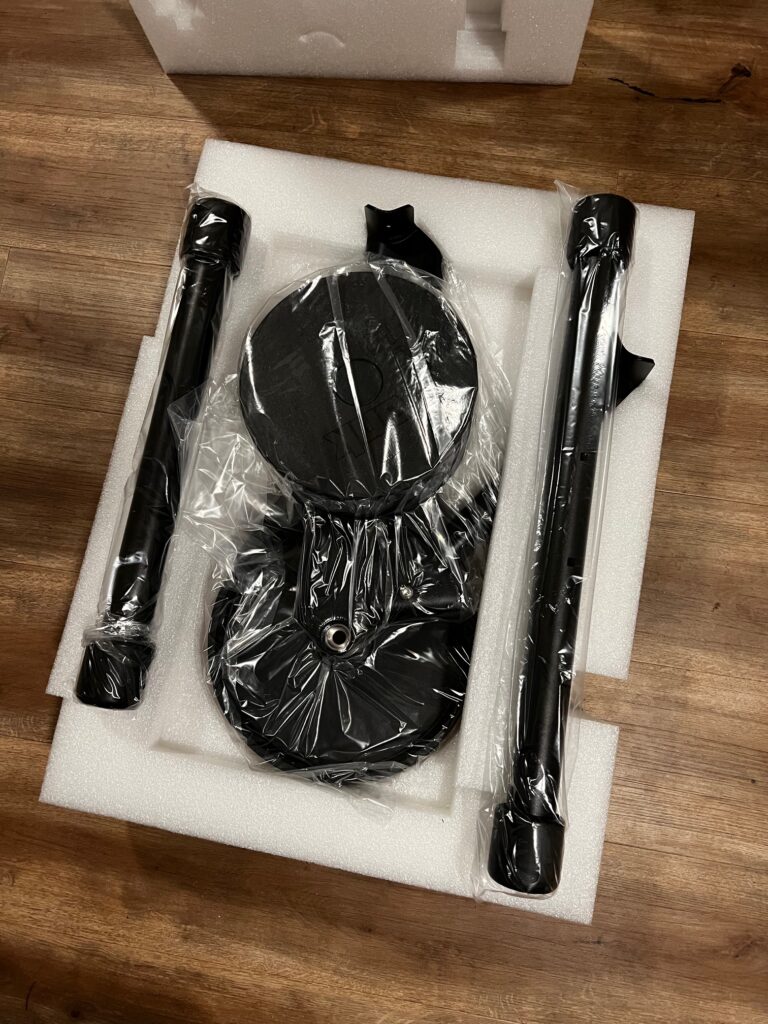
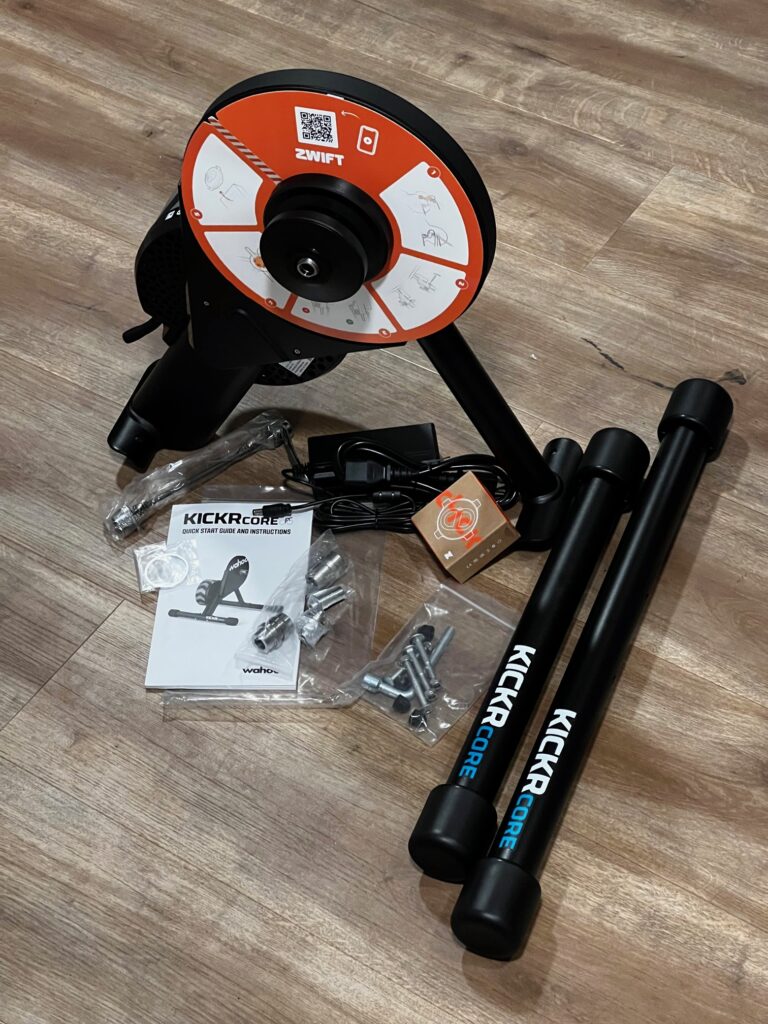
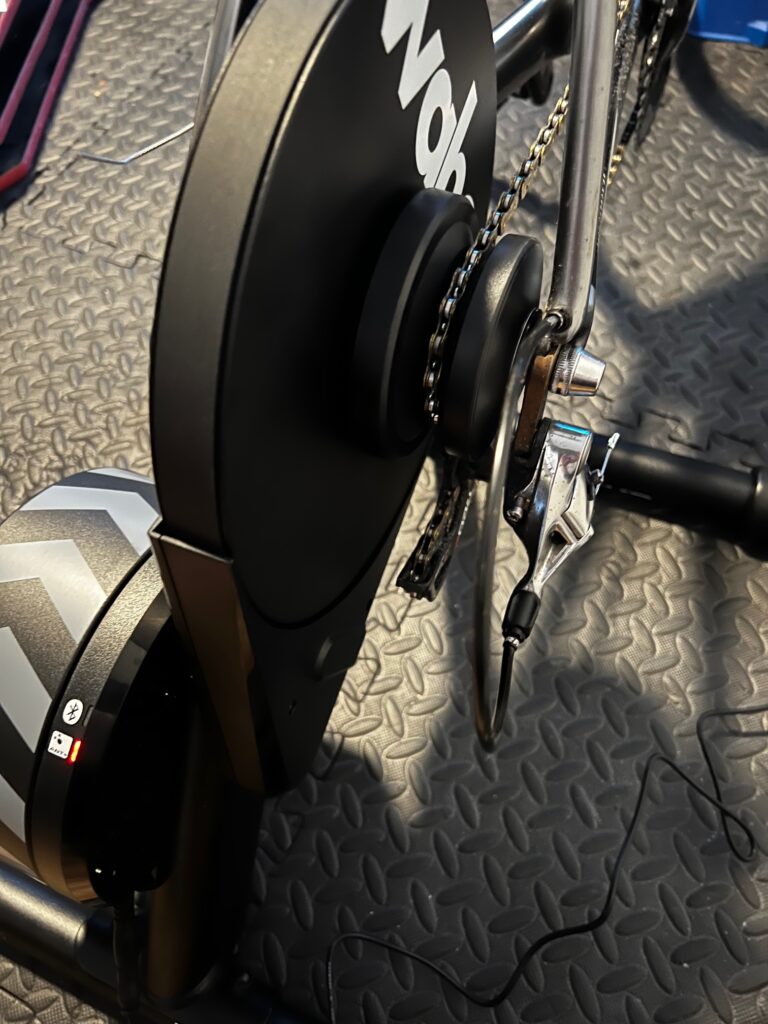
Firmware Updates
Checking for firmware updates whenever you get new hardware is always a good idea. This is especially true with the CORE One, since it’s shipping with older firmware that doesn’t support virtual shifting or auto-calibration!
Installing the new firmware is easy using the Wahoo app (available for iOS and Android). I added the CORE One to my list of sensors, clicked it for details, then clicked the “Update Firmware” button and followed the instructions:
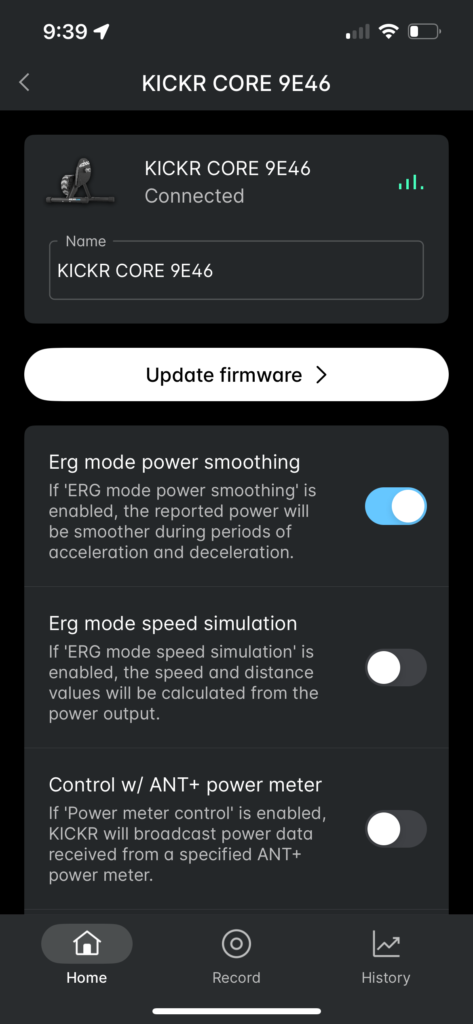

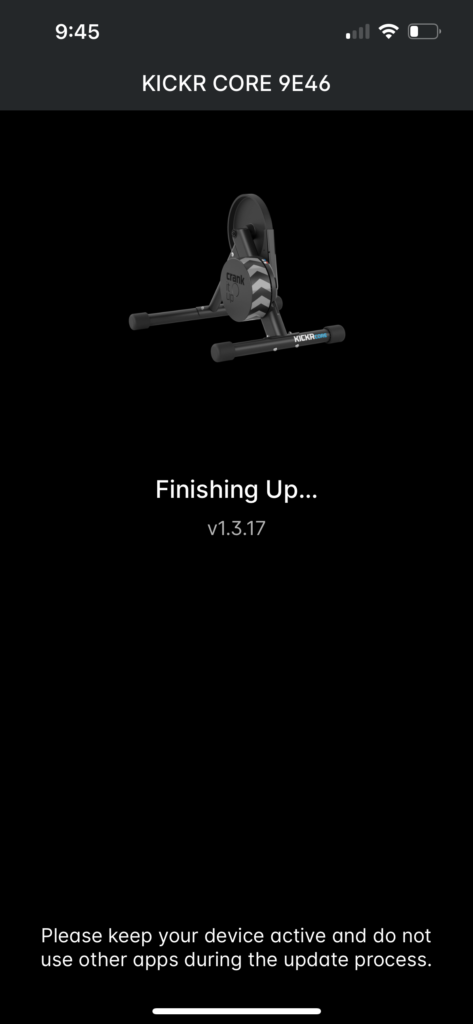
Note: when I installed the update, the app hung on the “Finishing up…” screen. After waiting for around 10 minutes, I restarted the app (which is a scary thing to do in the middle of a firmware update) and it showed the firmware as installed. The CORE One has been working fine ever since.
Bike Setup
I left my bike in a middle gear on the rear cassette, and it installed easily on the CORE One. After shifting up and down a few times I found the gear that was smoothest, and visually checked to see if it was lined up nicely on the cog. Good to go!
Ride Experience
Virtual Shifting

Of course, the big news with the CORE One is that it’s the first non-Zwift trainer to support virtual shifting. With virtual shifting, your chain doesn’t move between different rear cassette cogs when you shift. Instead, a virtual shift changes the resistance on your KICKR Core so it feels like you’ve changed cogs.
So how well does virtual shifting work on the CORE One? It works great! I tested it using the included Zwift Click and also the Zwift Play Controllers I already had installed on my Zwift bike. Both worked perfectly, without hiccups.
I will say the shift “curve” on the CORE One feels a bit different from the Zwift Hub – like a steady ramp up in resistance vs a quicker spike. But that’s not a bad thing… just different. Both trainers shift very quickly and smoothly.
One thing that isn’t mentioned much is that you must pair the CORE One via Bluetooth for virtual shifting to work. Then just pair the Zwift Click and/or Zwift Plays as well, and you’re good to go. The trainer automatically senses your gearing in the first few seconds of riding, then sets up your base resistance and puts you in 12th gear (you have a total of 24). And that’s it! Just use the Click’s +/- buttons, or the shift buttons on the Zwift Plays, to shift whenever you’d like.
I prefer the location of the Zwift Play shift buttons to the Click, because it’s reachable when my hands are in their default position on my hoods. Of course, if you’re on flat bars or some other setup, the Click may be better for you.
Noise Level
When it comes to noise levels, the CORE One is… cantankerous. It’s not the trainer’s fault – the actual KICKR Core trainer (flywheel, freehub, etc) is very quiet.
The issue is the Zwift Cog. I experienced the same noise issues with the Zwift Cog on the KICKR Core as I did with the Zwift Cog on the Zwift Hub. Specifically, there’s more chain/cog noise than I’d like.
But the noise level depends on your chain. And also your gearing.
I’ve tested the Zwift Cog with three different chains:
- The chain I’ve used for (literally) years on my Zwift bike (a YBN 11-speed chain)
- A nearly-new Dura-Ace 12-speed chain on my outdoor bike
- A new KMC 11-speed chain on my Zwift bike
All three chains received the same Molten Speedwax treatment, and all three have been tested to run near-silent on a standard cassette. None of them show as needing replacement when tested using Park Tool’s Chain Wear Indicator, although my well-used YBN chain is, logically, a bit stretched compared to the other two nearly new chains.
The Dura-Ace chain was the quietest of the three (+1 for expensive hardware, eh?), while my well-used YBN chain was the loudest. The KMC was somewhere in the middle.
I would characterize the noise level of the Dura-Ace chain as acceptable, while the other two are not. But I’m also fairly picky since I’m used to near-silent trainer setups!
As any cyclist knows, a noisy bike is an inefficient bike. When you hear drivetrain noise, you’re losing watts. So it hurts my cyclist heart to have a noisy chain/cog interface. It’s rough enough, in fact, that I can actually feel the teeth of the cog interfacing with my chain. That feeling is amplified the faster I turn my cranks.
This noise issue has been mentioned by other reviewers, too. Listen to DesFit do a nice comparison of the Zwift Cog vs cassette sound volume on the CORE One:
Zwift has always recommended riding in the little chainring when using the Zwift Cog + virtual shifting, and although they don’t say it, I can’t help but think part of the reasoning is because the Zwift Cog is quieter in the little ring. It’s quieter simply because the chain isn’t moving over the cog as rapidly. The faster the chain moves along the cog, the noisier it will be.
I may put together an article soon focused on taking apart the Zwift Cog and trying various things to make it quieter. What I’d really like to try is installing a cog from one of my spare cassettes, in place of the beefier steel cog used in the Zwift Cog, to see how that affects noise levels. Removing the plastic guides on either side of the cog will also reduce sound, but the truth is, Zwift needs to change something to make the Cog quieter.
The good news for KICKR Core owners is, you don’t need the Zwift Cog in order to enjoy virtual shifting. Just buy the Zwift Play Controllers, update your firmware, and you’re good to go on your existing cassette… which will be quieter than the Zwift Cog.
Power Accuracy
The KICKR Core’s new firmware brings what Wahoo calls “auto spindown calibration” to the trainer. This is just a wordy way of saying the trainer automatically calibrates itself for accurate power readings, so you don’t need to worry about doing it. Excellent news for KICKR Core owners!
Having completed several workouts, rides, and races with power dual recorded from the CORE One and my Favero Assioma pedals, I’d say my CORE One with its new auto-calibration is fairly accurate and close to being within spec… but it could use a bit of improvement.
First, as some other reviewers have already mentioned, you’ll need to put a hard ride or two into the CORE One before the auto calibration run enough to really dial in the accuracy. But that’s no big deal, and not unlike some other trainers.
My only real disappointment with power accuracy is that the CORE One seems to suffer from a bit of thermal drift, similar to the Zwift Hub. (Which is odd, since the CORE One has a thermal sensor, so Wahoo’s engineers should be able to compensate for temperature changes during a ride.)
Here’s an example (click to interact with the data):

My pedals were right with the CORE One when the ride began, but by the end the CORE One was reading around 5% higher. This is classic thermal drift, where a cold trainer reads higher the warmer it gets.
I’ve seen this on multiple rides, including sessions that began with the trainer already warm. Here’s a 90-minute ride that started with the trainer already warmed up. It’s reading a bit high to start, but even higher when the ride ends.
In these examples, if I’d stopped pedaling midride the CORE One would have recalibrated and probably improved in accuracy. But that shouldn’t be needed if the only issue is temperature.
You can see thermal drift again in my ZI Labs Power Meter test, where the CORE One reads a bit higher at the end than at the beginning:

That said, thermal drift isn’t apparent on all rides. Here’s a 40-minute race done just before the 90-minute ride linked above, and the CORE One is tracking nicely with my Assiomas throughout.
Oddly, I didn’t see the small-ring sprint issues that GPLama noted in his review, where his CORE One was rewarding him for being in the big ring (high flywheel speed) on sprints. The two sprints at the end of the workout above were done big ring (first sprint) little ring (second sprint).
Is the CORE One woefully inaccurate? Nah. It just appears that Wahoo’s engineers could tune the auto-calibration and/or temperature compensation algorithms to keep the trainer more firmly within the +/-2% accuracy specification.
Let’s be clear, though: compared to the days of manual KICKR CORE calibration, the auto-spindown feature is light years ahead, especially for the many Zwifters who rarely calibrate their CORE. My firm hunch is that this new auto spindown calibration will result in much more accurate power on average throughout the universe of CORE riders.
Inertial Feel
The CORE One’s 12lb flywheel is the same size as older KICKR trainers (generations 1-3). Many people say they can’t tell the difference between various physical or simulated flywheels, but I find the differences quite apparent, especially when accelerating my cadence or doing workout intervals.
The CORE One’s flywheel feels a bit better than the Zwift Hub, which makes sense since the Hub’s flywheel is a bit smaller. Still, the standard KICKR’s larger 18lb flywheel feels even better, which is partly why that trainer demands a higher price.
Wrapping It Up
Wahoo’s KICKR Core has the best reputation of any mid-range direct-drive trainer, which is why it commanded a price of $900 without a cassette for the first 5 years of its existence. Then Zwift entered the market with the bargain-priced Zwift Hub, a lawsuit happened, then a settlement… and here we are, with the KICKR CORE Zwift One available for $599 including a year of Zwift.
That’s a sweet deal, even if the Zwift Cog is noisy on some chains and power accuracy isn’t perfect.
With the CORE One replacing the Zwift Hub One moving forward, this is simply the best trainer for the money on the market today.
Questions or Comments?
Share below!